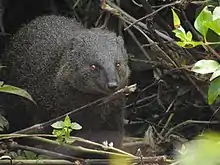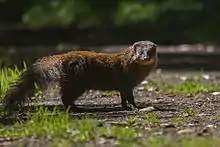Indian brown mongoose
The Indian brown mongoose (Herpestes fuscus) is a mongoose species native to the Western Ghats in India and the western coast in Sri Lanka. It is listed as least concern on the IUCN Red List.[1]
| Indian brown mongoose | |
|---|---|
 | |
| Indian brown mongoose in the southern Western Ghats | |
| Scientific classification | |
| Kingdom: | Animalia |
| Phylum: | Chordata |
| Class: | Mammalia |
| Order: | Carnivora |
| Suborder: | Feliformia |
| Family: | Herpestidae |
| Genus: | Herpestes |
| Species: | H. fuscus |
| Binomial name | |
| Herpestes fuscus Waterhouse, 1838 | |
 | |
| Indian brown mongoose range | |
Characteristics
The Indian brown mongoose appears large compared to the other mongoose species in southern Western Ghats. This species has a dark brown body and its legs are noticeably in black colour. The tail length is two-thirds of its body length and more furry than that of the small Indian mongoose. A pointed tail and fur beneath the hindleg help to distinguish this species from others.[2]
 From Western Ghats, India
From Western Ghats, India From Western Ghats, India
From Western Ghats, India An old illustration of H. f. maccarthiae
An old illustration of H. f. maccarthiae
Distribution and habitat
In South India, the Indian brown mongoose lives at an elevation range of 700–1,300 m (2,300–4,300 ft) from Virajpet in south Coorg and Ooty in the Nilgiri Hills, Tiger Shola in the Palni Hills, High Wavy Mountains in Madurai, Kalakad-Mundanthurai in Agasthyamalai Hills, Valparai plateau in the Anamalai Hills, and Peeramedu in Kerala.[1]
In the 1970s, it has been introduced to Fiji, where it lives in sympatry with the Javan mongoose.[3]
Behaviour and ecology
The Indian brown mongoose is nocturnal in nature, prefers to live in isolation, and maintains its habitats in dense forests. When ready to breed, Indian brown mongooses burrow in densely-packed rocks and give birth to two to three young. The brown mongoose is carnivorous, feeding primarily on small rodents, reptiles and at times also on birds.[3]
Taxonomy
Herpestes fuscus was the scientific name proposed by George Robert Waterhouse in 1838 for a greyish brown mongoose skin that had been purchased in Madras.[4]
References
- Mudappa, D.; Jathanna, D. (2015). "Herpestes fuscus". IUCN Red List of Threatened Species. 2015: e.T41612A45207051.
- Menon, V. (2014). Indian Mammals: A Field Guide. UK: Hachette. ISBN 9789350097618.
- Veron, G.; Patou, M.L.; Simberloff, D.; McLenachan, P.A. & Morley, C.G. (2010). "The Indian brown mongoose, yet another invader in Fiji". Biological Invasions. 12: 1947–1951. doi:10.1007/s10530-009-9616-z.
- Waterhouse, G.R. (1838). "On two new species of Mammalia, from the Society's collection, belonging to the genera Gerbillus and Herpestes". Proceedings of the Zoological Society of London. VI: 55–56.
